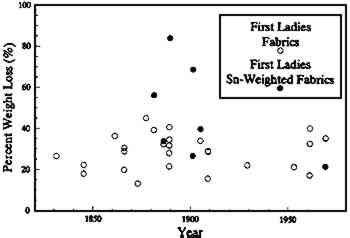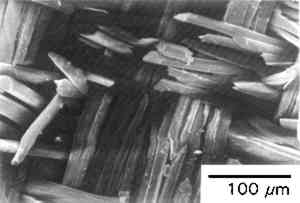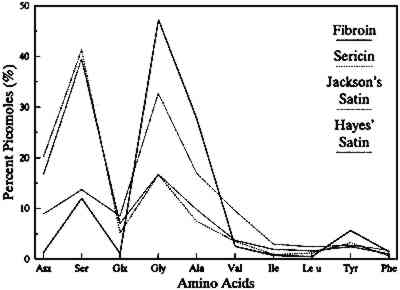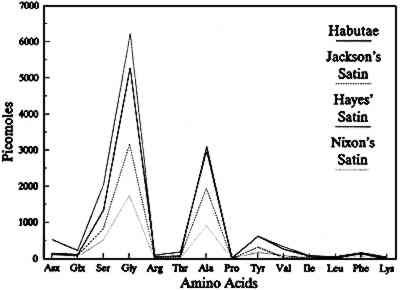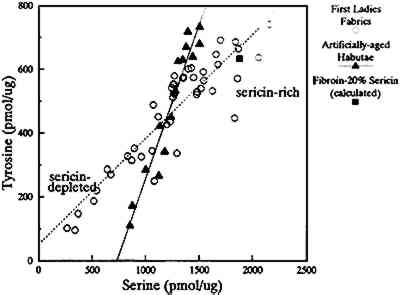THE U.S. FIRST LADIES GOWNS: A BIOCHEMICAL STUDY OF SILK PRESERVATIONMARY A. BECKER, POLLY WILLMAN, & NOREEN C. TUROSS
6 RESULTS AND DISCUSSION6.1 SOLUBILITY DATAMore than 88% of the silk fabrics evaluated from the First Ladies costumes lost more than 20% of their dry weight under denaturing conditions (fig. 2). Half the naturally aged fabrics had weight losses of greater than 30%. Although a 7M urea solution is more aggressive than a traditional conservation treatment with a mild detergent, it illustrates the strong possibility for material loss with solvent cleaning.
There is also a variation in the amount of weight loss in urea between different fabrics from the same garment. American-made silk fabrics were used for both Caroline Harrison's and Mary Harrison McKee's gowns, dating to President Benjamin Harrison's 1889 inauguration. In the 7M urea, fabrics from Caroline Harrison's gown had a 32–84% weight loss, while fabrics from Mary McKee's gown exhibited a 22–35% weight loss. Dating to a similar period, Frances Cleveland's 1886 wedding dress lost 32% and 34% of its original weight for the satin and lining fabrics respec- tively. These high percentages of weight loss cannot simply be attributed to removal of dust or other particulate matter that has adhered to the fabrics but is indicative at least in part of the loss of actual silk protein. The fabric samples known to be tin weighted tend to be more soluble than many nonweighted silk fabrics. Tin used as a weighting agent has been reported by conservators to accelerate the deterioration of silk based primarily on the loss in tensile strength of the fabrics (Bogle 1979). Caroline Harrison's apricot faille (1889) exhibited an 84% weight loss after urea extraction. This faille was also particularly friable when handled physically. Julia Grant, Edith Roosevelt, Ida McKinley, and Frances Cleveland's gowns contained tin-weighted lining fabrics that exhibited 45%, 40%, 69%, and 34% weight losses, respectively. The relatively new tin-weighted satin from Patricia Nixon's gown (1969) revealed only a 22% weight loss. The weighting of silk often results in “shattered” silk as evident by the lining fabric of Edith Roosevelt's gown (see fig. 3) showing the fiber fracture morphology associated with brittle materials (Bresee and Goodyear 1986; Hearle et al. 1989).
Compared to artificially aged silks, most of the First Ladies gowns have solubilities under denaturing conditions exceeding that of the 1000 kJ/m2 exposure to sunlight through glass (18%). Based on the artificially aged fabrics, 6.2 COMPOSITION OF THE EXTRACTED DEGRADATION PRODUCTSSince all the First Ladies silk gowns examined were soluble to some extent in 7M urea treatment, the composition of the proteinaceous material solubilized was analyzed. The amino acid compositions of the extracts from two of the gowns, Lucy Hayes's and Sarah Jackson's satins, revealed different protein constituents in the soluble material. As determined by postcolumn OPA IE-HPLC, the overall pattern of amino acids recovered from the extract of Sarah Jackson's satin is indicative of fibroin (i.e., large quantities of glycine and alanine with some serine) (fig. 4). It should be noted that the satin in Jackson's gown is probably early 20th century and consists of a silk warp–cotton weft. In contrast, the soluble extract from Lucy Hayes's satin (1877), which had a 45% weight loss, had an amino acid composition nearly identical to sericin (fig. 4).
The presence of sericin in the fabric increases the loss of silk fabrics under denaturing conditions due to the solubility of this protein. The present data suggest that any denaturing solvent treatment, in addition to removing surface contamination, presents the possibility of removing some proteinaceous material, either sericin or fibroin, from the silk garment. The artificially aged fabrics show an incremental loss of the protein with solubilization in urea, first associated with the amorphous regions of fibroin and secondarily from both the amorphous and crystalline regions of the fibroin as the dose and ultraviolet content of the incident radiation increase (Becker and Tuross 1994). The percentage of serine in both the urea-extracted silk degradation products and the overall exposed habutae remained constant, at approximately 11%, indicating an even distribution of serine throughout both the amorphous and crystalline regions. Thus for our artificially aged habutae, the amorphous regions of fibroin are degraded first under mild exposure conditions and then, as the UV content and dose increase, the whole fibroin matrix—crystalline and amorphous regions—are affected. This result provides evidence for threshold effects in the deterioration process of silk fibroin and suggests a selective deterioration mechanism that becomes random as exposure to light persists. Selective destruction of amino acids has been reported for both thermal decomposition reactions (Vallentyne 1964) and photodegradative experiments (Meybeck et al. 1971; Becker and Tuross 1994). 6.3 OVERALL FABRIC AMINO ACID COMPOSITIONThe amino acid analyses of 41 different fabric samples from the First Ladies collection yielded amounts of glycine, alanine, and serine in the characteristic 4:3:1 ratio of Bombyx mori fibroin. The fabrics were therefore confirmed as consisting primarily of silk. Minor variations in the compositions could be due to the effects of impurities such as starch coatings, dyes, mordants, and weighting agents, which could result in artifactual losses or alterations during the hydrolysis prior to analysis (Hunt 1985). As with the solubility data, there is no temporal correlation between the quantity of amino acids recovered and attribution date, even for different fabrics from the same garment. In artificially aged silk, there is a decrease in the total number of picomoles detected by A comparison of the amino acid profiles of three First Ladies fabrics shows that these naturally aged silks fall into two populations, sericin-rich and sericin-depleted. The amino acid profile of Hayes's satin is high in serine and aspartic acid, and the tyrosine content is comparable to new habutae. Both serine and aspartic acid are present in larger quantities in sericin than in fibroin (fig. 5). The combination of the overall amino acid data with the composition of the material extracted indicates that Hayes's satin can be considered sericin-rich.
Sarah Yorke Jackson's and Patricia Nixon's satins, which exhibit low amino acid recoveries, are notably lower in serine, glycine, alanine, and tyrosine content than new habutae. However, some of the fabrics can contain other fibers. For example, Jackson's satin includes a cotton weft, which, affecting the initial starting weight of the fabric, can slightly decrease the overall recovery. But the analysis of the proteinaceous material within the fabric can be useful as an investigative tool to evaluate the presence or absence of sericin. The material extracted from Jackson's satin indicates an absence of sericin. The decrease in the amount of serine present in the overall amino acid composition of the First Ladies fabrics compared to modern silk habutae is evidence that the sericin has been removed and the fabric is at risk. Nixon's satin is a relatively modern fabric (1969) that has probably been subjected to extensive processing, including essentially complete removal of the sericin, similar to the modern habutae. Tyrosine is known to be effectively degraded by light (McLaren and Shugar 1964), and its loss from fibroin is evidence that photodegradation has occurred (Becker and Tuross 1994). The two amino acids, serine and tyrosine, serve as proxy for the presence of sericin (serine) and photooxidative damage (tyrosine), and these can serve as an analytical tool to assess the general biochemical state of the silk fabrics (fig. 6).
The artificially aged fabrics (pure fibroin) show a linear decrease in both amino acids with a slope of nearly one (r2 = 0.923, slope = 0.969). The tyrosine-serine (pmol/%g) data for the First Ladies fabrics show that some samples contain more serine and tyrosine, while others have less of both compared to the artificially aged silks. Again the high serine content is indicative of the presence of sericin. When evaluated by linear regression analysis, the tyrosine-serine ratios of the First Ladies fabrics are best described by a line (r2 = 0.822) with a much lower slope than the artificially aged fabrics. The First Ladies fabrics indicate a smaller loss of tyrosine per loss of serine, particularly for those fabrics with serine contents greater than those of the habutae. Calculated tyrosine-serine points for compositions of fibroin with 20% and 30% sericin fall in the upper-right-hand corner of figure 6. Those amino acid compositions that show a serine content higher than the pure fibroin habutae have sericin associated with the fabric. Furthermore, tyrosine appears to be well preserved when a large serine content is present, probably due to the protective coating effect of sericin. Photodegradation is initially a surface phenomenon; thus the sericin coating could provide a screen for incident light or increase the length of the induction period before destruction of the main peptide chain by cleavage. |
